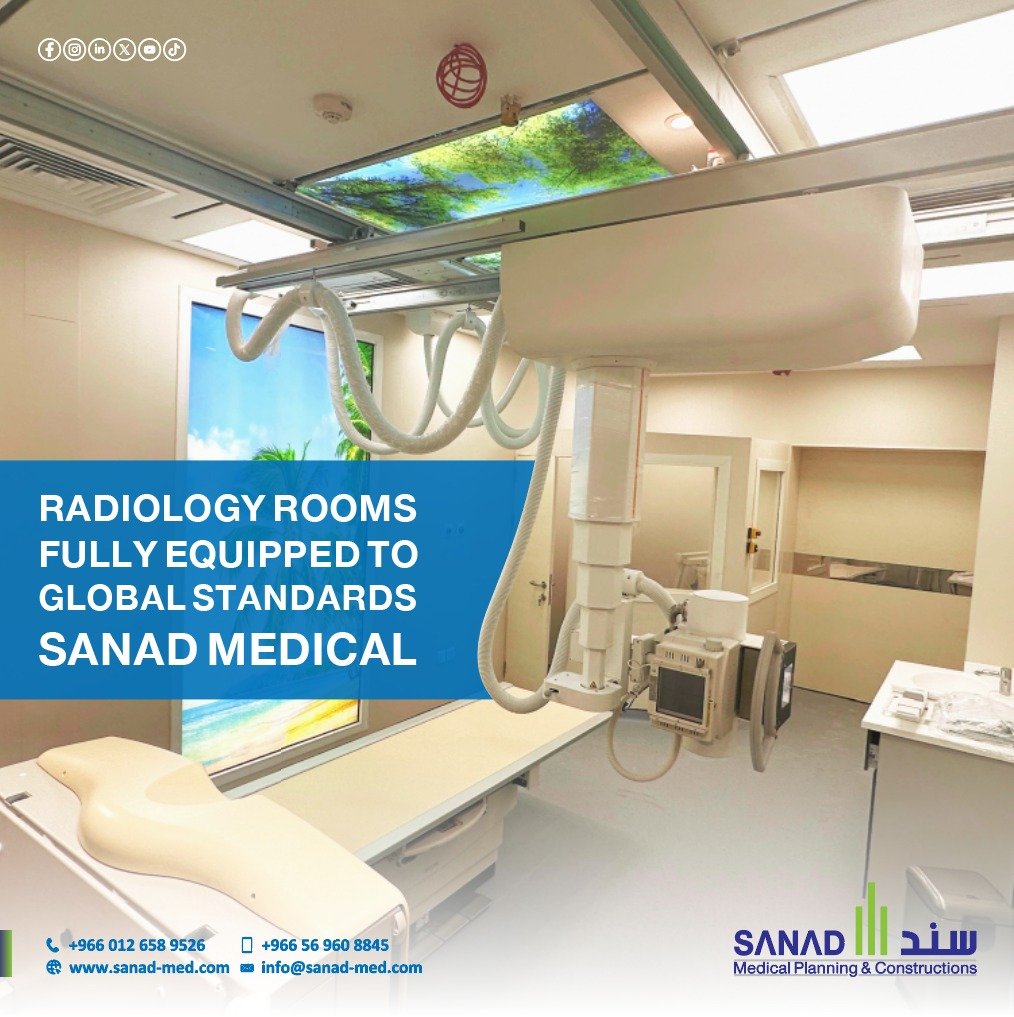X-ray rooms are a fundamental component of any modern healthcare system. They aren’t just spaces for E placing equipment; they are carefully designed, integrated environments that serve two main purposes: to provide the highest level of medical diagnosis and to do so in a safe environment for both patients and medical staff. The success of these rooms depends on their outfitting, which must meet strict engineering and health standards, from the infrastructure to the choice of equipment, ensuring operational efficiency and radiation safety. Given the rapid advancements in medical imaging, there is a clear need for a specialized partner like Sanad Medical Company, capable of providing comprehensive, integrated solutions that meet both local and international requirements.

The Importance of Specialized X-Ray Room Outfitting
The significance of professionally outfitting X-ray rooms cannot be overstated, as every detail directly impacts the quality of services and the safety of individuals. This importance is centered on three main axes:
1. Maximum Radiation Safety
X-ray rooms use various types of ionizing radiation which, despite its diagnostic importance, requires strict protective measures to prevent leakage. This is where lead shielding systems play a vital role. Lead sheets are integrated into the walls, doors, and even the floors and ceilings if necessary, forming a protective barrier that prevents radiation from reaching adjacent areas. Additionally, lead glass is installed in control rooms, allowing technicians and doctors to monitor the patient during the examination without being exposed to any danger. Adherence to standards set by the Saudi Ministry of Health and international bodies like the International Atomic Energy Agency (IAEA) is not an option; it’s a fundamental requirement for licensing and operating these facilities, and something Sanad Medical Company ensures through comprehensive testing to confirm the room is free of any radiation leaks before handover.
2. Ensuring Diagnostic Accuracy and Efficiency
The quality of a diagnosis largely depends on the clarity of the images produced by the equipment. Therefore, it is crucial to select medically approved devices from globally recognized brands. This includes digital X-ray machines that provide immediate, high-definition images; multi-slice CT scanners that speed up the scanning process; and high-field MRI machines (1.5 or 3 Tesla) that offer precise anatomical details of soft tissues. Furthermore, the room’s design must be engineered to facilitate the medical team’s movement around the equipment and reduce examination time, which increases the department’s productivity and shortens waiting lists.
3. Patient Comfort and Well-being
The examination environment is an integral part of the patient’s experience, especially during procedures that can cause anxiety, such as an MRI. A well-considered interior design helps to alleviate this stress by using appropriate lighting, calming colors, and even wall art that is comfortable to the eye. Providing communication systems between the patient and the control room, whether via a microphone or surveillance cameras, enhances their sense of security and allows them to communicate with the medical team at any moment, which improves the overall patient care experience.
Key Components of X-Ray Room Outfitting
The process of equipping a room involves several interconnected stages and components, none of which can be overlooked to achieve the highest standards:
1. Radiation Shielding Systems
This is the cornerstone of any X-ray room. It includes:
- Lead Sheets: Used to cover walls and doors, installed in an engineered manner to ensure there are no gaps that could allow radiation to pass through.
- Lead Glass: Installed in control room windows and doors to ensure a full view without exposure to risk.
- Lead-Lined Drywall: Pre-fabricated panels that simplify the installation process.
Strict radiation measurement tests are conducted after the shielding is complete, using specialized equipment to ensure that radiation levels inside and outside the room are within the safe limits defined by health authorities.
2. Medical Equipment
The equipment is chosen based on the medical facility’s needs and budget. This includes:
- Digital X-ray machines: Ideal for hospitals and clinics, providing high-quality images with lower radiation doses.
- CT Scanners: Essential in emergency departments and for complex diagnoses, providing three-dimensional cross-sectional images of internal organs.
- MRI machines: Do not use radiation and are crucial for diagnosing neurological, muscular, and joint diseases, with strengths ranging from 1.5 to 3 Tesla depending on the required precision.
- Ultrasound machines: Used in various specialties such as gynecology, cardiology, and vascular medicine.
3. Infrastructure
The infrastructure must be capable of supporting complex equipment. This includes:
- Dedicated Electrical Wiring: Capable of handling the high loads required by X-ray equipment, with protection systems against power fluctuations.
- Specialized HVAC Systems: Ensure stable temperature and humidity in the room, which is crucial for maintaining the efficiency and protecting the electronic equipment from damage.
- Medical Furniture and Fixtures: Such as examination tables, waiting chairs, and changing cabins, all of which must be compatible with the hygiene and safety requirements of a medical environment.
4. Engineering Design
The design is not just about aesthetics; it’s about efficiency and functionality. This includes:
- A Separate Control Room: Designed as the nerve center for examinations, equipped with high-resolution monitors and powerful computers for image processing.
- Clear Traffic Paths: Designed to separate the movement of patients, medical staff, and equipment, preventing congestion and reducing the risk of accidents.
The Role of Sanad Medical Company
Sanad Medical Company is a trusted partner in Saudi Arabia, providing integrated solutions that go beyond just supplying equipment. The company’s services begin at the initial engineering design phase, where its engineers create plans that meet the facility’s needs and comply with international standards. The company then handles the sourcing of medical equipment from leading global manufacturers and provides professional installation and commissioning services.
Its role doesn’t end there; it extends to include after-sales services such as periodic maintenance and continuous equipment updates, ensuring long-term efficiency and quality. Thanks to its extensive experience and specialized team, Sanad Medical Company guarantees that every X-ray room it outfits is safe, efficient, and equipped with the latest technology to provide the best possible diagnostic care.
Conclusion
Outfitting X-ray rooms represents a strategic investment in the future of healthcare. It is not just about installing equipment; it is a complex process that requires a deep understanding of safety, technology, and engineering. By partnering with a specialized company like Sanad Medical Company, hospitals and medical centers can ensure they provide a safe and reliable work environment capable of delivering accurate and fast diagnoses. Sanad Medical Company is committed to providing comprehensive solutions that start with a consultation and end with continuous technical support, so you are always at the forefront of advancements in medical imaging. For more information or to get a consultation about your outfitting needs, we invite you to contact our expert team.

